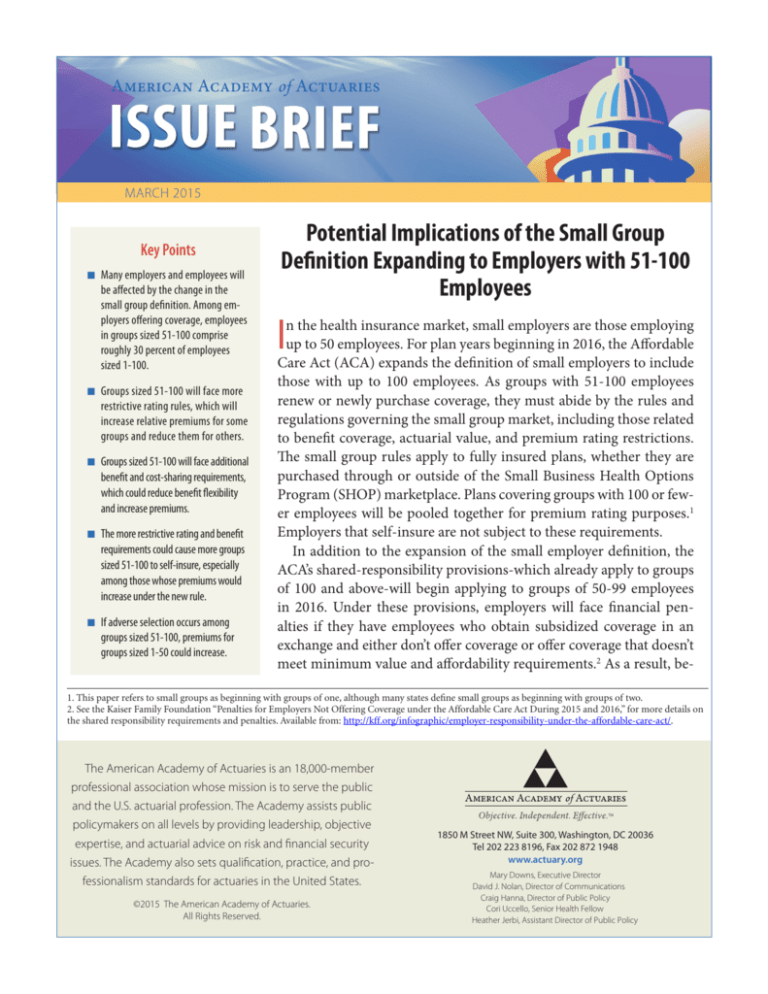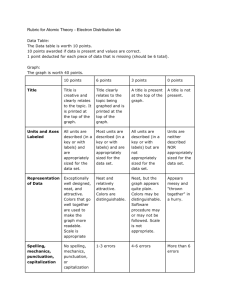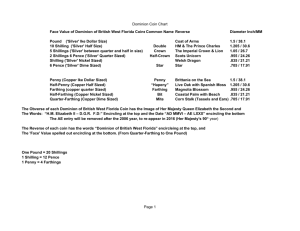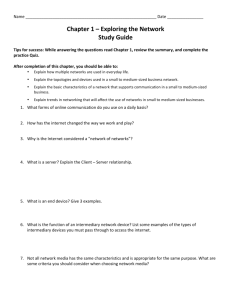
American Academy of Actuaries
MARCH 2009
MARCH 2015
Key Points
n Many employers and employees will
be affected by the change in the
small group definition. Among employers offering coverage, employees
in groups sized 51-100 comprise
roughly 30 percent of employees
sized 1-100.
n Groups sized 51-100 will face more
restrictive rating rules, which will
increase relative premiums for some
groups and reduce them for others.
n Groups sized 51-100 will face additional
benefit and cost-sharing requirements,
which could reduce benefit flexibility
and increase premiums.
n The more restrictive rating and benefit
requirements could cause more groups
sized 51-100 to self-insure, especially
among those whose premiums would
increase under the new rule.
n If adverse selection occurs among
groups sized 51-100, premiums for
groups sized 1-50 could increase.
Potential Implications of the Small Group
Definition Expanding to Employers with 51-100
Employees
I
n the health insurance market, small employers are those employing
up to 50 employees. For plan years beginning in 2016, the Affordable
Care Act (ACA) expands the definition of small employers to include
those with up to 100 employees. As groups with 51-100 employees
renew or newly purchase coverage, they must abide by the rules and
regulations governing the small group market, including those related
to benefit coverage, actuarial value, and premium rating restrictions.
The small group rules apply to fully insured plans, whether they are
purchased through or outside of the Small Business Health Options
Program (SHOP) marketplace. Plans covering groups with 100 or fewer employees will be pooled together for premium rating purposes.1
Employers that self-insure are not subject to these requirements.
In addition to the expansion of the small employer definition, the
ACA’s shared-responsibility provisions-which already apply to groups
of 100 and above-will begin applying to groups of 50-99 employees
in 2016. Under these provisions, employers will face financial penalties if they have employees who obtain subsidized coverage in an
exchange and either don’t offer coverage or offer coverage that doesn’t
meet minimum value and affordability requirements.2 As a result, be-
1. This paper refers to small groups as beginning with groups of one, although many states define small groups as beginning with groups of two.
2. See the Kaiser Family Foundation “Penalties for Employers Not Offering Coverage under the Affordable Care Act During 2015 and 2016,” for more details on
the shared responsibility requirements and penalties. Available from: http://kff.org/infographic/employer-responsibility-under-the-affordable-care-act/.
The American Academy of Actuaries is an 18,000-member
professional association whose mission is to serve the public
and the U.S. actuarial profession. The Academy assists public
policymakers on all levels by providing leadership, objective
expertise, and actuarial advice on risk and financial security
issues. The Academy also sets qualification, practice, and professionalism standards for actuaries in the United States.
©2015 The American Academy of Actuaries.
All Rights Reserved.
1850 M Street NW, Suite 300, Washington, DC 20036
Tel 202 223 8196, Fax 202 872 1948
www.actuary.org
Mary Downs, Executive Director
David J. Nolan, Director of Communications
Craig Hanna, Director of Public Policy
Cori Uccello, Senior Health Fellow
Heather Jerbi, Assistant Director of Public Policy
ginning in 2016, the small group market will
consist of employers with 1-100 employees
- those with 1-49 employees will not be subject to the shared-responsibility penalties but
those with 50-100 employees will face them.
As the small group market redefinition
takes effect, it’s important to consider the potential effects, not only on the groups sized
51-100, but also on those sized 1-50. The
American Academy of Actuaries’ Individual
and Small Group Market Task Force developed this brief to examine how the rules applying to groups sized 51-100 will change
and what that means for insurance offerings
in the small group market. Specifically, this
paper finds that:
n
n
n
Many employers and employees will be
affected by the change in the small group
definition. Among employers offering
coverage, employees in groups sized 51-100
comprise roughly 30 percent of employees
in groups sized 1-100.
Groups sized 51-100 will face more
restrictive rating rules, which will increase
relative premiums for some groups and
reduce them for others.
Groups sized 51-100 will face additional
benefit and cost-sharing requirements,
which could reduce benefit flexibility and
increase premiums.
n
n
The more restrictive rating and benefit
requirements could cause more groups sized
51-100 to self-insure, especially among
those whose premiums would increase
under the new rules.
If adverse selection occurs among groups
sized 51-100, premiums for groups sized
1-50 could increase.
Many employers and employees will be affected
by the new small-group definition
The extent of a potential disruption due to the change
in the definition of a small group depends in part on
the size of the small group market as well as the relative size of the 51-100 employer group market compared to the 1-50 employer group market.
Data from the Medical Expenditure Panel Survey
(MEPS) Insurance Component can be used to gauge
the numbers of potentially affected employers and
employees, even though the firm size categories of the
MEPS differ slightly from the categories affected by
the small group definition change. According to the
MEPS, there were 159,000 private-sector establishments with a firm size between 50 and 99 that offered
only fully insured coverage in 2013.3 Upon renewal
of their health insurance plan in 2016, any insurance
these groups obtain must meet the ACA small group
Private-Sector Establishments* Offering Coverage and Workers Enrolled, by Firm Size, 2013
Establishments Offering Only
Fully Insured Coverage**
Employees Enrolled in
Fully Insured Coverage
Firm Size
Number
(thousands)
Percent
Number
(thousands)
Percent
1-49 Employees
1,592
91%
8,393
71%
50-99 Employees
159
9%
3,413
29%
Total 1-99 Employees
1,752
100%
11,806
100%
Source: American Academy of Actuaries calculations of various MEPS Insurance Component tables available from: http://meps.
ahrq.gov/mepsweb/data_stats/summ_tables/insr/national/series_1/2013/ic13_ia_g.pdf
*Private-sector establishments include the self-employed with employees and incorporated self-employed with no employees,
but exclude the unincorporated, self-employed with no employees.
**Excludes establishments offering coverage that self-insure at least one plan, even if they also fully insure at least one plan.
3. In the MEPS, the unit of observation is an establishment, but the size categories reflect the entire firm. Establishments reflect a particular workplace or
physical location where business is conducted. A firm is a business entity consisting of one or more establishments under common ownership or control. A
firm represents the entire organization. In the case of a single-location firm, the firm and establishment are identical.
2
ISSUE BRIEF MARCH 2015
requirements, unless they have grandfathered coverage.4 Although establishments with 50-99 employees
comprised only 9 percent of all establishments with
fewer than 100 employees that offered coverage, there
were 3.4 million enrolled employees in these firms- 29
percent of the enrolled employees in firms with fewer
than 100 employees.
The Employee Benefit Research Institute (EBRI)
found similar results for 2012 when examining the
Current Population Survey (CPS).5 Among enrolled
employees in groups sized 1-99, 30 percent were in
groups with 50-99 employees. This figure includes
workers in both fully insured and self-insured plans.
Notably, both the MEPS estimates and the EBRI
estimates using the CPS focus on coverage of employees by firm size but do not reflect total numbers of
members, which not only includes employees but also
dependents. Therefore, the total numbers of affected
individuals are understated. Also, the relative size of
groups 1-50 and groups 51-99 could be different when
dependents are included.
Nevertheless, the number of employers and individuals who will be affected by the change in the small
group definition is sizeable. How they are affected-in
terms of benefit coverage and whether relative premiums would increase or decrease-will vary by group.
These issues are discussed in more detail below.
Groups sized 51-100 will face more restrictive
rating rules
Currently, issuers have broad flexibility in setting premiums for groups with 51-100 employees. There are
no federal limitations in premium-rate development,
and at the state level, fewer restrictions are in place
for groups sized 51-100 compared to those sized 1-50.
When the small group market is expanded, groups
sized 51-100 will face significant new rating restrictions. The only allowable characteristics on which the
rates may vary from one small group to another are
age, geographic area, tobacco use, and family size.6
The impact of these more restrictive rules on premiums for groups sized 51-100 will vary across groups.
Common rating variables for groups sized 51-100
that will be prohibited in 2016 include:
n Health status/historical group claims experience.
Currently, premiums can reflect the health status or
claims experience of the group. Beginning in 2016,
premiums cannot vary by health status or claims
experience of the group, as premiums must be set
based on the experience of the risk pool as a whole,
which includes all fully insured, non-grandfathered
small groups that are insured by the issuer in the
state.
n
n
n
Industry. Industry is commonly used to reflect the
differences in risk across groups.
Group size. The size of the employer is commonly
used as a rating variable to reflect administrative
efficiencies and adverse selection.
Gender. Although premiums do not vary by gender
within a group, issuers typically use age/gender factors when determining the overall premium of the
group. These factors capture not only the impact of
age on the cost of coverage, but also the impact of
gender, which varies by age. Gender rating will no
longer be permitted and, as described below, age
rating will be limited.
4. Many states have adopted the ACA transition program, which allows small employers renewing coverage prior to Oct. 1, 2016, to delay entering the ACAcompliant marketplace until after their 2016 plan year ends.
5. Paul Fronstin, “Sources of Health Insurance and Characteristics of the Uninsured: Analysis of the March 2013 Current Population Survey.” EBRI Issue
Brief No. 390. September 2013. Available from: http://www.ebri.org/pdf/briefspdf/EBRI_IB_09-13.No390.Sources1.pdf
6. Premium discounts also are available to groups with wellness programs.
Members of the Individual and Small Group Market Task Force include Chairperson, Karen Bender, MAAA, ASA, FCA; Eric
Best, MAAA, FSA; Philip Bieluch, MAAA, FSA, FCA; Joyce Bohl, MAAA, ASA; April Choi, MAAA, FSA; Richard Diamond, MAAA,
FSA; James Drennan, MAAA, FSA, FCA; Scott Fitzpatrick, MAAA, FSA; Rachel Killian, MAAA, FSA; Kuanhui Lee, MAAA, ASA;
Timothy Luedtke, MAAA, FSA; Barbara Niehus, MAAA, FSA; Jason Nowakowski, MAAA, FSA; James O’Connor, MAAA, FSA;
Bernie Rabinowitz, MAAA, FSA, FCIA, FIA, CERA; David Shea Jr., MAAA, FSA; Karin Swenson-Moore, MAAA, FSA; Steele Stewart,
MAAA, FSA; Martha Stubbs, MAAA, ASA; David Tuomala, MAAA, FSA, FCA; Rod Turner, MAAA, FSA; Cori Uccello, MAAA, FSA,
FCA, MPP; Dianna Welch, MAAA, FSA, FCA; and Thomas Wildsmith, MAAA, FSA
ISSUE BRIEF MARCH 2015
3
n
Employee participation rates and employer contribution shares. Issuers often use these factors to reflect
adverse selection, since higher participation rates
and employer subsidies can be indicative of a better
mix of health risks.
Additional federal limitations on the allowable rating
variables that begin to apply to the 51-100 market in
2016 include:
n Age. Premiums for the group can reflect its age distribution, but the age rating factors are prescribed
and may not vary for adults by more than a ratio
of 3 to 1. That is, the rate for a 64-year-old cannot
be more than three times the rate for a 21-year-old.
Currently, issuers’ age factors often reflect up to a
5-to-1 ratio or higher.
n
n
n
Geography. Geographic regions within the state are
prescribed and may be significantly different than
the regions currently used by issuers.
group market, issuers bill employers by listing the rate
applicable to each enrolled employee, based on the age
of each member-employee and dependent-enrolled in
the plan.7 This is referred to as list billing. In contrast,
for groups sized 51-100, issuers usually use composite rating, in which the premiums shown on the bill
represent the average rate for each family size coverage tier offered. Issuers also may choose to offer its
small groups a composite premium option, and the
total group premium would be the same as that under
list billing. The approach determining the composite
premium would be the same as that under list billing.
The approach determining the composite premium
for the small group market, however, is very different
from that currently used for groups sized 51-100. If
list billing is extended to the 51-100 group market, it
will introduce administrative complexity for that market that does not exist today.
Tobacco use. Premiums may be increased to reflect
tobacco use but not by more than 50 percent.
Groups sized 51-100 will face additional benefit
and cost-sharing requirements
Family size. At most, three children under the age
of 21 within a family may be charged a premium.
Additional children receive coverage at no additional charge.
When the expanded small group definition becomes
effective, groups sized 51-100 will for the first time be
under ACA plan-design requirements that already apply to groups sized 1-50. First, these groups will be
subject to the essential health benefits (EHB) requirement, which defines the set of health care service categories that must be covered by the plan. EHBs include
some benefits, such as pediatric dental, that typically
are not included in plans in the large group medical
market. Second, all plans must satisfy a metallic benefit level ranging from bronze to platinum, reflecting
the actuarial value of the plans’ cost-sharing features
(i.e., the portion of covered benefits paid for by the
plan, on average).
When these new requirements were imposed on
small groups sized 1-50 beginning in 2014, they did
not significantly impede plan-design flexibility, because these groups were already subject to a fairly
limited range of benefit-design choices. Compared to
groups with 50 or fewer employees, however, groups
with more than 50 employees typically have had more
flexibility in the benefit options from which they
could choose, both from a covered-services perspective as well as for specific cost-sharing features. The
ACA requires non-grandfathered plans for groups
These new rules may result in significant premiumrate changes for some groups, depending on the cumulative impact of the elimination or limitation of
the various rating factors. These changes could have
either a positive or a negative impact on the renewal rates for groups sized 51-100 in 2016. Premium
changes will vary based on characteristics of the firm
(e.g., firm size, industry, geographic location) and of
its insured population, including employees and their
dependents (e.g., age, gender, health status). For instance, the compression of premiums due to the agerating restrictions will increase the relative rates for
groups with a younger population and reduce them
for groups with an older population. Similarly, the
prohibition of health-status rating will increase the
relative premiums for groups with a healthy population and reduce them for those with less healthy populations.
In addition to the changes in allowable premium
rating factors, groups sized 51-100 could face a change
in how issuers bill for group coverage. In the small
7. As noted above, a maximum of three children under the age of 21 can be billed as dependents for a specific employee.
4
ISSUE BRIEF MARCH 2015
larger than 50 to comply with provisions related to annual out-of-pocket limits, annual benefit limits, and
coverage of preventive services with no consumer cost
sharing.8 But aside from these requirements and the
60 percent minimum value requirement, the ACA allows large groups a great deal of flexibility regarding
covered benefits and other limitations on plan-design
features.
As a result, the new requirements will impose a
greater reduction in benefit and cost-sharing flexibility for groups sized 51-100 than they currently experience. Plans likely will need to be changed to meet benefit coverage and actuarial value requirements. Such
changes also could affect premiums. For instance,
upward pressure on premiums could result if the EHB
and cost-sharing requirements result in more generous coverage.
Younger and healthier groups sized 51-100 may
face increased incentives to self-insure
Groups sized 51-100 that will be subject to the small
group market rules may have increased incentives
to self-insure. A primary reason might be to avoid
a higher premium in the fully insured, small group
market due to premium-rating limitations and benefit and cost-sharing requirements. A self-funded
Prevalence of Self-Funding
Employers that offer health insurance benefits can opt to purchase fully insured coverage, or they can
opt to bear the insurance risks themselves and self-insure. The Employee Retirement Income Security
Act (ERISA) exempts self-insured health plans from state health insurance regulations, including
issue and rating rules and benefit requirements. As a result, self-insured groups can have more flexibility regarding benefit coverage and plan design, and their costs more directly reflect their actual
claims. Self-insured groups are also exempt from state premium taxes and the ACA health insurance
fee levied on fully insured plans. Although self-insuring can subject firms to risks of unexpected high
claims, this risk can be limited through the purchase of stop-loss coverage.
Employer size, in particular, is a primary factor in determining whether it is feasible for an employer
to self-insure. In smaller groups, large year-to-year fluctuations in claims can occur, making it more
difficult and risky to budget directly for health costs. As group size increases, however, health claims
are likely to be more predictable and stable. Indeed, the prevalence of self-funding generally increases
by firm size.
Percent of Private-Sector Enrollees That Are Enrolled in Self-Insured Plans at Establishments
That Offer Health Insurance, by Firm Size, 2013
Firm Size
Percent of Enrollees in Self-Insured Plans
1-10
13.1%
11-24
9.7%
25-49
11.9%
50-99
14.3%
100-999
33.6%
1,000+
85.6%
Source: American Academy of Actuaries calculations of various MEPS Insurance Component tables available from:
http://meps.ahrq.gov/mepsweb/data_stats/summ_tables/insr/national/series_1/2013/ic13_ia_g.pdf
An employer’s demographic characteristics, which factor into expected health costs, also can influence whether it self-insures. For instance, groups with younger or higher-paid employees may be
more likely to self-insure than those with older or lower-paid employees.
8. In addition to these provisions, plans were no longer allowed to impose benefit limitations on pre-existing conditions or to charge higher cost-sharing for
emergency services provided out of network.
ISSUE BRIEF MARCH 2015
5
group’s health plan costs more directly reflect its own
claims experience and demographics. Therefore,
groups more likely to see relative premium increases,
including those with a younger and healthier population, may have the greatest incentives to self-insure.
Offsetting these potential advantages are: a greater
fluctuation in cash flow associated with self-funding;
potentially greater financial risk, depending on the
morbidity of the group; and a greater assumption of
administrative responsibilities as well as compliance
and reporting requirements, which generally are
within the domain of the insurer. Reinsurance mechanisms and third-party administrators can mitigate
these disadvantages.
Although self-insurance typically has been more
prevalent among larger firms, lower stop-loss attachment points have become more available, making
self-insurance with stop-loss coverage a more viable,
and less risky, option for small employers. In addition, self-insuring becomes somewhat less risky to
plans after the small group definition is extended, because it provides these groups the protection of guaranteed issue coverage. Currently, if a member of the
self-insured group has a significant continuing claim,
the employer’s costs will increase. In the underwritten large group market, the employer may have difficulty renewing its stop-loss coverage or finding a fully
insured plan with a premium not reflecting the high
cost of that continuing claim. As a small group, however, the employer could apply for fully insured, small
group coverage at rates that do not reflect health status or claims experience. Once the claim is resolved,
it could be possible for the employer to revert back
to self-insurance. Notably, an EBRI study found that
after Massachusetts implemented health reforms in
2006, self-funding increased for all firm sizes greater
than 50.9
If higher-cost groups sized 51-100 continue to opt
for fully insured coverage but more lower-cost groups
self-insure, the small group, single risk pool plans
would experience adverse selection. Premiums for
these plans would increase as a result.
Adverse selection among groups sized 51-100
could increase premiums for groups sized 1-50
Current premiums for groups sized 1-50 reflect the
average costs for these groups. When the small group
definition is extended, then premiums in the small
group market will change to reflect the influx of
groups sized 51-100. If the average costs for groups
sized 51-100 that enter the market exceed the current average costs of groups sized 1-50, due to adverse
selection or other reasons, small group rates would
increase as a result. In response to any higher premiums, groups sized 1-50 may reconsider their decision
to offer health insurance, especially because they are
not subject to the employer-shared responsibility provisions.
Although it is possible that premiums for groups
sized 1-50 would decline if groups sized 51-100 are
lower cost on average than smaller groups and they
opt to continue to fully insure, factors exerting upward
pressure on premiums are more likely to dominate.
The premium impact on groups sized 1-50 will
depend not only on the average costs of the groups
sized 51-100 relative to those of groups sized 1-50, but
also the distribution by group size within the 1-100
market. There are more than twice as many covered
employees in the 1-50 group size category than in the
51-100 category, which would somewhat moderate
the premium impact.
The full impact of the small group definition
change on premiums will occur over several
years
Many states have adopted the ACA-transition program, which allows small employers to delay entering
the ACA-compliant marketplace until after their 2016
plan year ends.10 Groups sized 51-100 that would face
higher costs or less attractive benefit plans by moving to an ACA-compliant small group plan would be
more likely to renew their current plans into 2017, after which they would need to move to a small group
plan if they want fully insured coverage. This postponement would likely result in higher small group
market premiums in 2016. Such an increase could be
9. Paul Fronstin, “Self-Insured Health Plans: State Variation and Recent Trend by Firm Size.” EBRI Notes: 33(11). November 2012. Available from: http://
www.ebri.org/pdf/notespdf/ebri_notes_11_nov-12.slf-insrd1.pdf
10. The March 4, 2015, CMS Bulletin, “Insurance Standards Bulletin Series - Extension of Transitional Policy through October 1, 2016,” gives states the option of deferring compliance with the expanded small group definition for groups renewing their policies on or before Oct. 1, 2016. This is a state-by-state
decision. Available from: http://www.cms.gov/CCIIO/Resources/Regulations-and-Guidance/Downloads/transition-to-compliant-policies-03-06-2015.pdf
6
ISSUE BRIEF MARCH 2015
temporary to the extent that lower-cost groups eventually purchase small group plans in 2017 rather than
moving to self-insured plans. Therefore, a new equilibrium may be delayed until 2018, with premium impacts differing in the intervening years.
Conclusion
For plan years beginning in 2016, the definition of
small employers will expand from employers with
1-50 workers to also include those with 51-100 workers. Such a change could affect over 150,000 establishments with more than 3 million workers. Groups sized
51-100 will face more restrictive rating rules, which
likely would increase relative premiums for some
groups, such as those with younger and healthier
populations, and reduce relative premiums for others,
such as those with older and sicker populations. Additional benefit and cost-sharing requirements could
increase the comprehensiveness of coverage, and
could also reduce plan-design flexibility and increase
premiums. These changes may provide increased
incentives for groups sized 51-100 to self-insure in
order to avoid these requirements. In particular, the
prevalence of self-insurance among lower-cost groups
could increase. If such adverse selection were to occur,
average premiums could increase not only for fully insured groups sized 51-100 but also for groups sized
1-50, because these two subgroups will be combined
for premium rating purposes.
ISSUE BRIEF MARCH 2015
7








